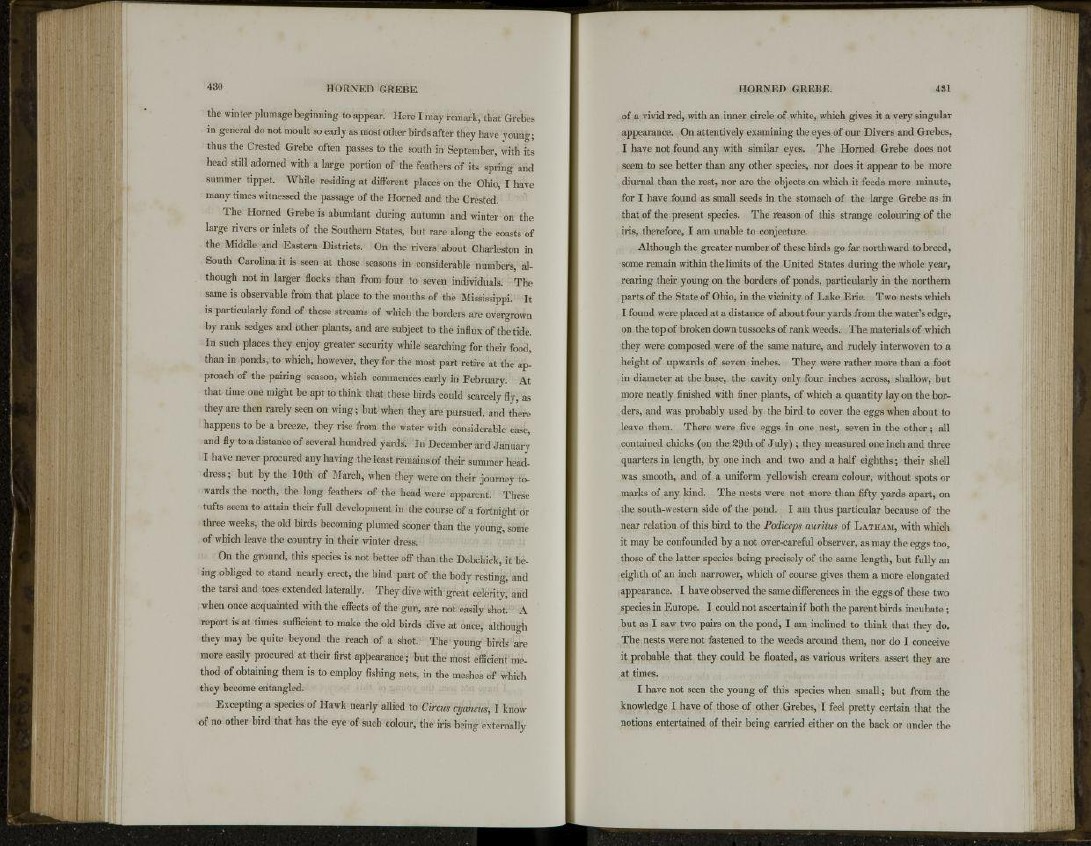
the winter plumage beginning to appear. Here I may remark, that Grebes
in general do not moult so early as most other birds after they have young;
thus the Crested Grebe often passes to the south in September, with its
head still adorned with a large portion of the feathers of its spring and
summer tippet. While residing at different places on the Ohio, I have
many times witnessed the passage of the Horned and the Crested.
The Horned Grebe is abundant during autumn and winter on the
large rivers or inlets of the Southern States, but rare along the coasts of
the Middle and Eastern Districts. On the rivers about Charleston in
South Carolina it is seen at those seasons in considerable numbers, although
not in larger flocks than from four to seven individuals. The
same is observable from that place to the mouths of the Mississippi. It
is particularly fond of those streams of which the borders are overgrown
by rank sedges and other plants, and are subject to the influx of the tide.
In such places they enjoy greater security while searching for their food,
than in ponds, to which, however, they for the most part retire at the approach
of the pairing season, which commences early in February. At
that time one might be apt to think that these birds could scarcely fly, as
they are then rarely seen on wing; but when they are pursued, and there
happens to be a breeze, they rise from the water with considerable ease,
and fly to a distance of several hundred yards. In December ard January
I have never procured any having the least remains of their summer headdress
; but by the 10th of March, when they were on their journey towards
the north, the long feathers of the head were apparent. These
tufts seem to attain their full development in the course of a fortnight or
three weeks, the old birds becoming plumed sooner than the young, some
of which leave the country in their winter dress.
On the ground, this species is not better off than the Dobchick, it being
obliged to stand nearly erect, the hind part of the body resting, and
the tarsi and toes extended laterally. They dive with great celerity, and
when once acquainted with the effects of the gun, are not easily shot. A
report is at times sufficient to make the old birds dive at once, although
they may be quite beyond the reach of a shot. The young birds are
more easily procured at their first appearance; but the most efficient method
of obtaining them is to employ fishing nets, in the meshes of which
they become entangled.
Excepting a species of Hawk nearly allied to Circus cganeus, I know
of no other bird that has the eye of such colour, the iris being externally
of a vivid red, with an inner circle of white, which gives it a very singular
appearance. On attentively examining the eyes of our Divers and Grebes,
I have not found any with similar eyes. The Horned Grebe does not
seem to see better than any other species, nor does it appear to be more
diurnal than the rest, nor are the objects on which it feeds more minute,
for I have found as small seeds in the stomach of the large Grebe as in
that of the present species. The reason of this strange colouring of the
iris, therefore, I am unable to conjecture.
Although the greater number of these birds go far northward to breed,
some remain within the limits of the United States during the whole year,
rearing their young on the borders of ponds, particularly in the northern
parts of the State of Ohio, in the vicinity of Lake Erie. Two nests which
I found were placed at a distance of about four yards from the water's edge,
on the top of broken down tussocks of rank weeds. The materials of which
they were composed were of the same nature, and rudely interwoven to a
height of upwards of seven inches. They were rather more than a foot
in diameter at the base, the cavity only four inches across, shallow, but
more neatly finished with finer plants, of which a quantity lay on the borders,
and was probably used by the bird to cover the eggs when about to
leave them. There were five eggs in one nest, seven in the other; all
contained chicks (on the 29th of July) ; they measured one inch and three
quarters in length, by one inch and two and a half eighths; their shell
was smooth, and of a uniform yellowish cream colour, without spots or
marks of any kind. The nests were not more than fifty yards apart, on
the south-western side of the pond. I am thus particular because of the
near relation of this bird to the Podiceps auritus of LATHAM, with which
it may be confounded by a not over-careful observer, as may the eggs too,
those of the latter species being precisely of the same length, but fully an
eighth of an inch narrower, which of course gives them a more elongated
appearance. I have observed the same differences in the eggs of these two
species in Europe. I could not ascertain if both the parent birds incubate ;
but as I saw two pairs on the pond, I am inclined to think that they do.
The nests were not fastened to the weeds around them, nor do I conceive
it probable that they could be floated, as various writers assert they are
at times.
I have not seen the young of this species when small; but from the
knowledge I have of those of other Grebes, I feel pretty certain that the
notions entertained of their being carried either on the back or under the